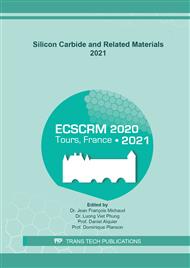[1]
C. Calabretta, et al. Effect of Nitrogen and Aluminum Doping on 3C-SiC Heteroepitaxial Layers Grown on 4° Off-Axis Si (100), Materials, 14(16), 2021, 4400.
DOI: 10.3390/ma14164400
Google Scholar
[2]
V. Scuderi et al. Characterization of 4H-and 6H-like stacking faults in cross section of 3C-SiC epitaxial layer by room-temperature μ-photoluminescence and μ-raman analysis, Materials, 13(8) 2020, 1837.
DOI: 10.3390/ma13081837
Google Scholar
[3]
F. La Via et al. New approaches and understandings in the growth of cubic silicon carbide, Materials, 14(18), 2021, 5348.
Google Scholar
[4]
H. Nagasawa et al., 3C-SiC hetero-epitaxial growth on undulant Si(0 0 1) substrate J. Cryst. Growth, 237–239 (2002) 1244-1249.
DOI: 10.1016/s0022-0248(01)02233-3
Google Scholar
[5]
R Anzalone et al. Temperature investigation on 3C-SiC homo-epitaxy on four-inch wafers, Materials 12 (20),2019, 3293.
DOI: 10.3390/ma12203293
Google Scholar
[6]
M Zimbone, et al. Extended defects in 3C-SiC: Stacking faults, threading partial dislocations, and inverted domain boundaries, Acta Materialia 213, 2021,116915.
DOI: 10.1016/j.actamat.2021.116915
Google Scholar
[7]
S. Ha & W. M. Vetter,A Simple Mapping Method for Elementary Screw Dislocations in Homoepitaxial SiC Layers, Material Science Forum, . 389- 393 (2002) 443-446.
DOI: 10.4028/www.scientific.net/msf.389-393.443
Google Scholar
[8]
G. Linda. Shapiro and C. George Stockman Computer Vision, Prentice-Hall, New Jersey, ISBN 0-13-030796-3, 279–325.
Google Scholar
[9]
L. Barghout and L. W. Lee Perceptual information processing system., Paravue Inc. U.S. Patent Application 10/618,543, filed July 11, (2003).
Google Scholar
[10]
https://www.mathworks.com/discovery/image-segmentation.html.
Google Scholar


